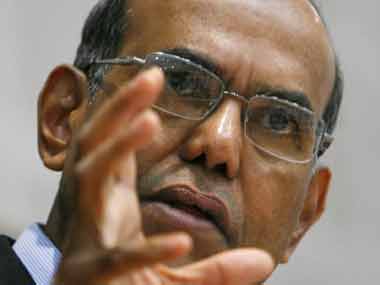The Finance Minister wants the Reserve Bank to cut interest rates; the latter thinks it is better to wait till the fiscal deficit shows signs of coming under control.
The FM wants to push growth up; the latter want to push inflation down. Who is right?
The jury is out, since raising growth is important to reducing the fiscal deficit; but growth won’t rise if inflation continues to blight investment decisions. Unstable inflation tends to blight long-term investment decisions.
In the short run, though, it is best to look at market signals to see if rates will come down. And this is what recent signals are telling us.
[caption id=“attachment_541122” align=“alignleft” width=“380”]
 Even if the RBI cuts repo rates at its mid-quarter policy review, and P Chidambaram leans on public sector banks to cut their margins, banks are reluctant. Reuters[/caption]
Even if the RBI cuts repo rates at its mid-quarter policy review, and P Chidambaram leans on public sector banks to cut their margins, banks are reluctant. Reuters[/caption]
First, credit growth continues to outstrip deposit growth. RBI statistics show that in the week to 2 November, year-on-year bank credit grew at 16.2 percent while deposits grew by 13.7 percent. This shows that banks may not have much spare cash to lend. No case for cutting rates from their viewpoint.
Second, the overnight money market is also flashing red on liquidity stress. Banks are borrowing over Rs 1,00,000 crore from the RBI through the repo rate. Money is tight.
Third, the liquidity situation will get worse as 15 December approaches, since companies will have to pay advance taxes. A Business Standard report says this means another Rs 50,000-60,000 crore will be sucked out of the system, and banks will need to borrow more from the repo window for most of December.
Fourth, the market is refusing to accept lower-interest bonds. Public sector Oriental Bank of Commerce recently offered 8.93 percent interest on 15-year bonds worth Rs 1,025 crore. The issue devolved on the underwriters, says an Economic Times report . Reason: similar bonds were trading at higher yields in the secondary market. The market is saying rates need to stay high.
Fifth, the Rural Electrification Corporation is issuing tax-free bonds of 10 and 15-year tenures at rates of 7.72 percent and 7.88 percent respectively for retail investors. For taxpayers in the top 30 percent bracket, the pre-tax yield works out to more than 10 percent. Another sign that investors want higher yields at a time of high inflation.
What these developments tell us is this: there is no real reason for interest rates to fall now, when the economy is into its busy season.
ICICI Bank Managing Direct and CEO Chanda Kochhar said rates have to fall over time, but it may not happen in the short run. She told The Times of India in an interview: “Over a period, rates have to soften. We have seen that happen in wholesale deposits. But it has not fully resulted in reduction of cost of funds for banks. Current and savings account balances are not growing. So, on balance the cost of funds has come down but not as sharply.”
The bottomline: even if the RBI cuts repo rates at its mid-quarter policy review, and P Chidambaram leans on public sector banks to cut their margins, banks are reluctant. The actual borrower may not feel the difference for a while.
)